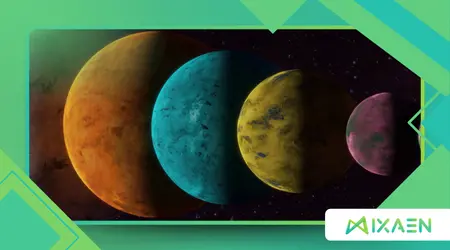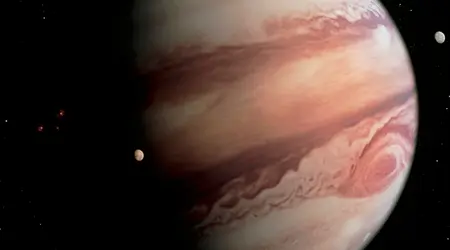Can Gaseous Exoplanets Host Life? Exploring the Possibilities Beyond Our Solar System

The search for extraterrestrial life has long fascinated humanity, and with the discovery of thousands of gaseous exoplanets, the question arises: Could these massive, swirling worlds support life?
Anúncios
Unlike rocky planets like Earth, gaseous exoplanets are composed primarily of hydrogen, helium, and other volatile compounds, creating environments that seem inhospitable at first glance.
However, recent scientific advancements suggest that life might not be limited to terrestrial planets.
This article delves into the intriguing possibilities, challenges, and cutting-edge research surrounding the potential for life on gaseous exoplanets.
The Nature of Gaseous Exoplanets: A Hostile Haven?
Gaseous exoplanets, often referred to as “hot Jupiters” or “mini-Neptunes,” are characterized by their thick atmospheres and lack of solid surfaces.
These planets orbit stars outside our solar system and are typically much larger than Earth.
Their atmospheres are dominated by gases like hydrogen, methane, and ammonia, with extreme pressures and temperatures that vary dramatically depending on their distance from their host star.
One might assume that such conditions would immediately rule out the possibility of life.
After all, how could organisms survive in an environment without a solid ground, where storms rage with winds exceeding 1,000 miles per hour, and temperatures can swing from scorching heat to freezing cold?
Yet, nature has a way of surprising us.
On Earth, extremophiles—organisms that thrive in extreme environments—have been found in the most unlikely places, from hydrothermal vents at the bottom of the ocean to acidic hot springs.
Could similar life forms exist in the upper atmospheres of gaseous exoplanets?
The Case for Atmospheric Life
While the surfaces of gaseous exoplanets may be uninhabitable, their upper atmospheres present a more intriguing scenario.
Scientists have theorized that microbial life could potentially float in the cooler, more stable layers of these planets’ atmospheres.
On Earth, bacteria and other microorganisms have been found floating at high altitudes, surviving on organic molecules and sunlight.
Similarly, the upper atmospheres of gaseous exoplanets could harbor regions where temperatures and pressures are moderate enough to support life.
A study published in The Astrophysical Journal in 2021 explored this possibility, suggesting that certain gaseous exoplanets with hydrogen-rich atmospheres could host microbial life.
The researchers proposed that these microbes might metabolize organic compounds or even use hydrogen as an energy source, much like some extremophiles on Earth.
+ Artificial Structures Around Exoplanets: The Search for Alien Megastructures
Challenges to Life on Gaseous Exoplanets
Despite these tantalizing possibilities, significant challenges remain.
One major hurdle is the lack of a solid surface, which means that any potential life forms would need to remain suspended in the atmosphere indefinitely.
Additionally, the intense radiation from nearby stars could pose a threat to any organisms, especially on planets that orbit close to their host stars.
Another challenge is the scarcity of essential elements like oxygen, carbon, and nitrogen in the atmospheres of gaseous exoplanets.
While these elements are present in trace amounts, they may not be sufficient to support complex life forms.
However, some scientists argue that life could evolve to use alternative elements or energy sources, adapting to the unique conditions of these worlds.

The Role of Technology in Unlocking Mysteries
Advancements in space technology are crucial to answering the question of whether gaseous exoplanets can host life.
Telescopes like the James Webb Space Telescope (JWST) are equipped with instruments capable of analyzing the atmospheres of distant planets.
By studying the chemical composition and weather patterns of these worlds, scientists can identify potential biosignatures—indicators of life, such as unusual concentrations of gases like methane or oxygen.
For example, the detection of phosphine gas in the atmosphere of Venus sparked debates about the possibility of microbial life on our neighboring planet.
While the findings remain controversial, they highlight the importance of continued exploration and the potential for unexpected discoveries.
Comparing Gaseous Exoplanets to Known Habitable Worlds
To better understand the potential for life on gaseous exoplanets, it’s helpful to compare them to known habitable worlds.
Earth, with its liquid water, stable climate, and protective magnetic field, is often considered the gold standard for habitability.
However, moons like Europa and Enceladus, which orbit gas giants in our own solar system, have shown signs of subsurface oceans and geothermal activity, raising the possibility of life in unexpected places.
The table below compares key characteristics of Earth, Europa, and a hypothetical habitable gaseous exoplanet:
| Characteristic | Earth | Europa | Gaseous Exoplanet |
|---|---|---|---|
| Surface Type | Rocky | Icy | Gaseous |
| Atmosphere Composition | Nitrogen, Oxygen | Thin, Oxygen | Hydrogen, Helium |
| Potential for Life | High | Moderate (subsurface) | Atmospheric |
This comparison underscores the diversity of environments that could potentially support life, challenging our traditional notions of habitability.

The Search for Biosignatures
One of the most promising avenues for detecting life on gaseous exoplanets is the search for biosignatures.
These are chemical or physical markers that indicate the presence of living organisms.
For example, the simultaneous detection of oxygen and methane in a planet’s atmosphere could suggest biological activity, as these gases are typically unstable together unless replenished by life.
The table below outlines potential biosignatures and their significance:
| Biosignature | Significance |
|---|---|
| Oxygen (O₂) | Produced by photosynthetic organisms |
| Methane (CH₄) | Can indicate microbial life |
| Phosphine (PH₃) | Potential marker of anaerobic life |
| Water Vapor (H₂O) | Essential for life as we know it |
While these biosignatures are not definitive proof of life, they provide valuable clues for astronomers to follow.
The Ethical Implications of Discovering Life
The discovery of life on gaseous exoplanets would have profound implications for our understanding of biology, philosophy, and our place in the universe.
It would challenge the notion that life is unique to Earth and open up new possibilities for the diversity of life forms that could exist.
However, it also raises ethical questions about how we should interact with extraterrestrial life, if at all.
For instance, should we attempt to communicate with potential life forms, or would doing so risk contaminating their environment?
These questions highlight the need for careful consideration and international cooperation as we continue to explore the cosmos.
Conclusion: A Universe of Possibilities
The question of whether gaseous exoplanets can host life is far from settled, but the possibilities are undeniably exciting.
While these worlds present significant challenges, they also offer unique environments that could support life in ways we have yet to imagine.
As technology advances and our understanding of astrobiology deepens, we may one day find that life is not only possible on gaseous exoplanets but thriving in ways that defy our current understanding.
The search for life beyond Earth is a journey of discovery, one that challenges us to think creatively and remain open to the unexpected.
Whether or not gaseous exoplanets are home to life, their study enriches our understanding of the universe and our place within it.
